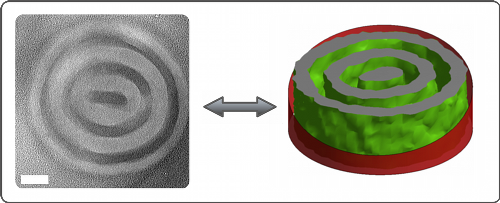Multi-scale and Coarse-grained Modeling
Personnel: Erik C. Allen, Kirill Titievsky
Self-assembly of amphiphilic molecules, such as lipids and block copolymers, relies on correlations in molecular motion that extend well beyond the atomic scale. Consequently, predicting the precise course of cooperative phenomena in these systems requires molecular simulations involving 102-104 of molecules. Such simulations are computationally impractical unless the molecular models are highly simplified or “coarse-grained”. The typical approach to coarse-graining is to postulate a convenient, physically reasonable model and fit it to data from experiments, detailed simulations, or well-established limiting theories. While often successful, these assumptions are typically made in a way that cannot guarantee that the model is valid away from the fitting conditions or for other observable variables.
Providing such guarantees, and more generally, constructing quantitatively reliable coarse-grained molecular models and simulation methodology, is the central goal of this research effort. We approach this challenge through rigorous investigation of the physical implications of all model assumptions and, crucially, the fitting variables and conditions. In recent years, we have focused on two problems: micellization of low molecular weight model nonionic surfactants using implicit solvent models and ordering of block copolymer melts of realistic molecular weights (104-106 g/mol) using bead-spring models.
Micellization commonly occurs at very low surfactant concentrations. Thus, there is a significant computational advantage in accounting for the solvent by modifying the interactions among the surfactant molecules instead of explicitly simulating the solvent. Until now this has been done by adjusting the interaction potentials among the surfactant atoms until their radial distribution functions (RDFs) in absence of the solvent agreed with explicit solvent simulations at a fixed concentration. We find, however, that extrapolating from dilute to critical concentrations, it is essential that the potentials are fit separately for different surfactant concentrations. Moreover, in addition to reproducing the RDFs, the implicit solvent model must also correctly match the free energy of solvation, which requires the introduction of a one-body, surfactant-density dependent free energy term. These modifications have allowed us to predict the critical concentration of a model surfactant system to within a factor of five while reducing the computation time by an order of magnitude compared to explicit solvent simulation. [J. Chem. Phys. 128 (2008) 154115, J. Chem. Phys. 130 (2009) 034904]
The challenge of simulating block copolymers is that their dimensions and the characteristic scale of their ordered phases are much larger than the atomic dimensions. This has lead to the development of a variety of arbitrary molecular models, such as lattice chains and bead-spring models with soft interactions using only an order 10 particle per molecule. We put these models on a common basis by interpreting them as “path-integral” approximations of the well-characterized standard Gaussian chain model (GCM) and related field theoretic simulations. This has allowed us to construct a bead-spring model that is guaranteed to reproduce GCM to within a controlled tolerance, enabling simulations with well-defined molecular weight and component miscibility (through the Flory-Huggins interaction parameter). This model has been applied to validating the perturbation predictions of the critical behavior of block copolymers (the BLHF theory) and a detailed study of the effect of confinement of block copolymers in cylindrical geometries, revealing substantial deviations from the strong stretching behavior typically assumed in these systems in high-level analyses. [ J. Chem. Phys. 128 (2008) 124902 and manuscripts in preparation]
